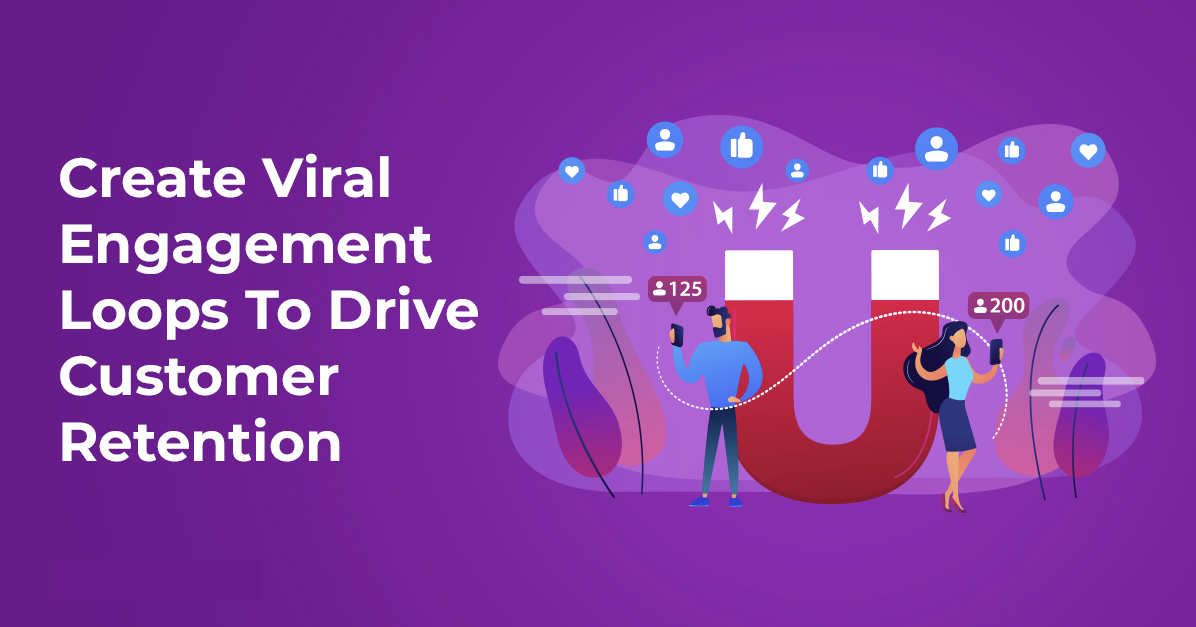Create Viral Engagement Loops To Drive Customer Retention
Your customers will always be your best salespeople.
Think about the last time you tried a new restaurant, downloaded a new app, or subscribed to a newsletter. Why did you do it?
Did you get a personal sales call from the restaurant owner or app developers themselves? Of course not! Chances are, a friend nudged you in their direction, accompanied by an, “Oh my gosh, you have to try this amazing new [blank] I just found.” And the second you followed through on your friend’s raving five-star review, you became part of a viral growth loop.
Growth loops transform your customer base into an extension of your marketing team — and help you create exponential growth for your company.
In this article, you’ll learn what growth loops are, how they improve on the AARRR funnel, and how you can leverage them for compounding growth. We wrote this post with insight from Amanda Goetz, founder of House of Wise, Chief Marketing Officer for Teal, and former Vice President of Marketing of The Knot. With her expertise and our tips and tricks, you’ll be able to incorporate growth loops into your business like a pro.
The Basics of the AARRR Funnel
Before we dive into growth loops, it’s important to first understand traditional growth and customer acquisition methods, especially the AARRR funnel. The AARRR funnel was developed by Dave McClure in 2007 and has been the go-to growth model for many years. While this funnel has served businesses well, today’s increasingly connected consumer environment demands a different approach, which is where growth loops come in.
The AARRR funnel is popular because it provides an easy-to-follow framework for finding new customers and retaining repeat visitors through various marketing efforts. The funnel stands for:
- Acquisition: You use marketing efforts including writing new content, optimizing content for search engines, and paid marketing to acquire new customers.
- Activation: Your customers are activated by clicking on CTAs, filling out contact forms, or signing up for newsletters.
- Retention: You create processes to retain repeat visitors or purchases by using subscription programs and email marketing campaigns.
- Referral: You encourage customers to refer friends and family to your products using social media and incentive programs.
- Revenue: You generate money from each user while also taking into account the cost of the customer acquisition.
Here’s what the AARRR funnel looks like.

The AARRR funnel is an exceptional growth marketing strategy that has helped millions of businesses grow, but it has some significant drawbacks.
First, it creates closed systems and silos within your company. For example, your marketing team may be entirely focused on customer acquisition while the product team only emphasizes products and product features that drive customer retention. That means your team often only gets a look at a small portion of the customer journey.
Second, AARRR funnels drive linear growth. That means these growth methods often suffer from a lack of innovation or can get stuck targeting the same groups of people — without discovering similar target audiences. That means you may be thrilled that the funnel works great at the beginning, only to find that it limits your growth and expansion.
Finally, funnels are easy to replicate. There are thousands of blogs that business owners can use to copy another business’s growth strategy. That leaves little room for showing how your product is unique or stands out from the competition.
Viral growth loops offer all of the strengths of the AARRR funnel, but without some of its significant weaknesses.
The Basics of Growth Loops
Instead of five segmented steps, the growth loop model breaks things down into four steps: input, activate, action, and output. This is an open system that inherently helps build growth into the next cycle.

- Input: A new customer signs up for your newsletter or fills out a survey form based on your offerings.
- Activate: You learn about different target audience trends and preferences.
- Action: Your company sends out relevant information such as suggested products or services based on their answers or interests indicated in the survey or newsletter selection.
- Output: The customer purchases a relevant product based on your suggestions and recommends your services or products to friends.
Focusing on Viral Loops

Here’s how traditional marketers and sales teams think: We’ll start with a large pool of people, then slowly narrow that pool down through various touch points. By the bottom of the funnel, we’ll have a handful of people primed to buy.
Wouldn’t your efforts pay a larger return if, instead, you started with a small, loyal user base that grew into an exponentially larger audience? By expanding word-of-mouth marketing from one-to-one to one-to-many, you can implement a viral marketing campaign.
That’s the logic behind viral engagement and content loops. You tap into the hearts and minds of your active users, who then tell your friends about your company. When they do, two things happen:
- Your initial users provide a number of referrals, leading to new users or customers.
- Your new users improve the overall experience for your initial users, improving customer retention.
When you combine the two, you get viral growth for your company.
Why Growth Loops are a Better Alternative than the AARRR Funnel Method
Growth loops improve on the AARRR funnel method in several ways.
Rather than creating silos, these growth methods are all about giving a broader overview of the entire customer journey. That way, each team member is involved in improving functionality and product growth while keeping the customer’s needs in mind.
Instead of marketers focusing on the best ways to optimize content and improve monetization, they also get a look at how various products may perform differently for different segments of the market.
Growth loops are also less limiting and linear compared to the AARRR method. With growth loops, you’re constantly encouraging existing customers and new ones to find new ways to use your products. Paired with recommendations and viral engagement, these loops can accelerate growth outside of the small subset of your audience that the AARRR method targets.
Above all, growth loops can help you differentiate your business from competitors. While there is some overlap and you can certainly draw inspiration from other businesses’ growth loops, creating successful loops means knowing your company and highlighting what makes it unique.
Types of Viral Loops: Choosing the Engagement Opportunity for Your Company
Now, you just need to figure out which loops work best for your business. Here are a few ideas to help get you started:
- Offer an incentive: Uber capitalized on referral codes when it first arrived on the ride-sharing scene. By sharing a code with friends, both you and your friend get a discount — creating a positive experience for you while helping expand Uber’s engaged user base.
- Create a referral program: There are a number of ways to encourage engaged users to refer their friends to your service. Dropbox was able to exponentially grow its user base by offering free storage space in exchange for referrals.
- Encourage social shares: Imagine how dull social media would be if you couldn’t share the experience with friends. On Instagram, you elevate the experience by sharing photos with friends; on Slack, you can easily collaborate with colleagues sharing similar interests.
- Create a personalized experience: Quizzes, games, and other opt-ins are fun because they create something tangible for the user. Once one user sees their results, they want to share them with their friends.
- Offer a discount: If you run an ecommerce site, you can easily offer a discount in exchange for customer referrals. If an existing customer refers a friend to your website, they can receive a coupon once their friend makes a purchase.
- User-generated content: If you run a blog or a content site, you can increase your exposure through guest posts and other user-generated content. Once a user publishes their post, they’ll invite their audience to view it on your website.
Examples of Growth Loops
A classic example of a successful growth loop is Netflix’s platform. Customers create an input by consuming content. Netflix activates further engagement by using an algorithm to learn about the customer’s watching preferences. It then curates the catalog to include the types of things (genres, actors, etc.) the user enjoys watching and makes recommendations based on past viewing. The customer uses the suggestions to continue viewing more content.
Many companies have several growth loops running at the same time, but this is a good overview of what the process looks like.
Within growth loops, there are also several types companies can use:
- Viral loops, which is what we discuss in the podcast with Amanda. Essentially, a user interacts with a product or service and then recommends it to their friends or followers.
- User-generated content, or UGC, loops work when a user creates their own content, which is indexed for search engines to draw in more users who will in turn create more content. Pinterest and TikTok are good examples of this type of growth loop.
- Paid loops are when businesses spend money on advertising or paid search to draw in users. When the user signs up or purchases a product, that money is used to generate more advertising to acquire new customers.
Create Growth Loops Through Content Marketing
There are obvious ways to implement viral growth loops, including referral codes, affiliate links, and two-for-one pricing options. The best examples of viral loops — the originators of viral engagement, if you will — are social media networks. When Twitter, LinkedIn, and Instagram launched, users invited their friends to join. Once their friends joined, it improved the overall experience for the initial user, as suddenly they had friends to send messages to, comment on posts, and tag them in photos.
At the same time, growth loops come in many forms, and may not appear as “viral” as your typical social network or meme. At Growth Machine, we are a B2B services company, so it may not seem like there is a lot of opportunity to create successful growth loops. While we aren’t going viral on TikTok, we’re using growth loops — like referrals and new user acquisition loops — to continue growing our business.
Our blog and podcast are also examples of less obvious growth loops. When we publish a blog post or podcast episode featuring thought leaders (like Amanda Goetz), the interviewee usually shares the post or episode with their audience, which draws in more readers or listeners, some of whom, in turn, share it with their networks.
We credit our growth primarily to peer referrals, which is a form of growth loop. While we began as a small agency with a handful of clients and a team of freelance writers, our testimonials led us to sustainable growth, with a full in-house team, 50+ freelancers, and a portfolio of clients we’re proud to serve.
How to Use Viral Engagement Loops to Grow Your Startup
Amanda used viral engagement loops long before she launched House of Wise. Here are some examples.
Create a Quiz That Drives Retention
Amanda’s past experience as a wedding planner informed how she approached viral loops during her time at The Knot. As a wedding planner, she did a wedding-style quiz with each of her clients to better understand their overall vision and aesthetic.
She developed a similar wedding style and vision quiz for users of The Knot. People who are planning their weddings can take this “swipe left”-style quiz and get vision inspiration. The results page offers suggested venues and other ideas — it’s a printed asset that they’re encouraged to share with their vendors.
The viral result? The quiz produced happier couples who were more likely to refer their friends to The Knot, and made The Knot vendors want to work with more couples from The Knot. It helped the couple better articulate their vision, and it also made The Knot the place that could help facilitate those conversations. It’s a B2C quiz that also helped grow the B2B side of their business.
Improve the Experience for Every Type of User
In the case of The Knot, the site offers a free, professional-looking wedding website to each couple where they can include wedding details, accommodations, their love story, photos, registry and more, all with The Knot’s branding tastefully placed throughout. When guests look at a couple’s wedding website, it elevates their experience at the wedding too, as they’ve had a polished, well thought-out experience from the first touch.
Many wedding guests are likely to be in the same stage of life as the happy couple. When they see how easy The Knot website is to navigate, a positive first impression is set, and these guests are more likely to use the platform themselves when it comes time to plan their own wedding. And maybe they’ll even recommend it to other engaged couples, further driving the viral growth loop.
But guests aren’t the only ones who benefit from the brand’s wedding website experience. It helps the couple organize the wedding planning, track guest RSVPs, and facilitate a registry that’s easy for the couple to compile and guests to shop. Guests can also easily navigate all their questions (thanks to detailed landing pages for the couple, wedding party, venue, and accommodations).
Implement a Referral or Affiliate Program
Now a veteran in using viral growth loops to expand her business, Amanda has relied on the power of affiliate programs for her new startup, House of Wise.
House of Wise sells luxury CBD products and empowers its community to help drive sales with their Wise Women affiliate program. There are no costs, quotas, recruiting, or any of the negative aspects often associated with referral programs. Just a referral link and % of sale bonus referring friends and family to a product they already love. So why wouldn’t they?
Increase Virality Through Growth Loops
On episode 19 of the Growth Machine Marketing podcast, Amanda explains what a growth loop is, how she used one of them throughout her five years at The Knot, and how she plans to create viral loops within her startup, House of Wise.
Every marketer understands the value of a rave review. But not every marketer understands how to make those client referrals go viral.
Viral loops transform your most engaged users into your marketing team, inviting their friends and family members to your service. A number of viral companies, from Uber, Dropbox, Instagram, and LinkedIn, have used viral loops to increase their exposure.
As a content marketer, your job is to create real connections with your loyal user base, so you can capitalize on this word-of-mouth engine. Not all viral loops will work for your business model — it’s up to you to determine which feel most authentic and will incentivize your existing customers.







